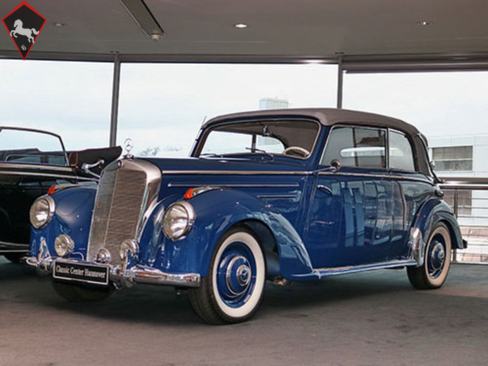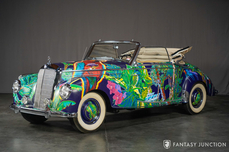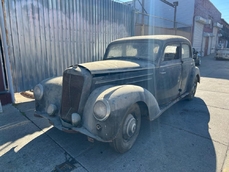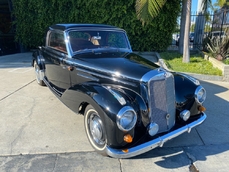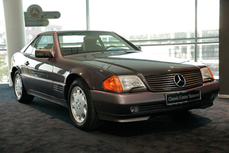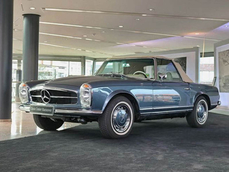Mercedes-Benz 220 W187 Cabriolet B (1953) 1953
General description :
Preis:
EUR 149.850,– (§25a UStG differenzbesteuert)
Fahrzeughistorie:
Damals wie heute basieren die Mercedes Coupés und Cabrios technisch größtenteils auf den Limousinen der entsprechenden Baureihen. So auch hier: Der viertürige Mercedes-Benz 220 ( W187 ) "Personenwagen" konnte erstmals im April 1951 auf der IAA in Frankfurt bestaunt werden.
Technisch war das neue Modell wesentlich weiterentwickelt worden. Optisch jedoch glich das Erscheinungsbild noch deutlich den Vorgängern aus der "Vorkriegs-Ära", deren Konstruktion bis in die 30er Jahre zurückreichte. Gleichzeitig kam ein neu entwickelter 6-Zylinder Motor zum Einsatz. Der moderne, seidenweich laufende Motor stellte erheblich mehr Leistung zur Verfügung - und erfüllte endlich den lang-gehegten Wunsch der anspruchsvollen Kundschaft nach einem sportlichen Reisewagen. Die 80 (später 85) PS aus sechs Zylindern waren mehr als doppelt so viel, als die meisten der zeitgenössischen Autos damals leisteten. Das garantierte überlegene Fahrleistungen. Die hochwertige Verarbeitung mit vielen großartigen Details, die üppige Verwendung von Holz, Leder und viel Chromzierrat kann auch heute noch als "Luxus pur" bezeichnet werden. Nach wie vor: Diese Autos gehören zur gehobene Preisklasse.
Die Modell-Familie umfasste vier Versionen:
16.066 gebaute 4-türige Limousinen - es haben trotz der für die damaligen Verhältnisse relativ hohen Auflage nur wenige Autos überlebt. Entsprechend überschaubar ist das heutige Angebot.
1.278 gebaute Cabriolets "A" ( eine Seitenscheibe ) - sie bestechen durch ihre ausgewogenen Proportionen und gehören zu den gesuchtesten Modellen dieser Baureihe. Hier sind nur wenige gute Fahrzeuge verfügbar.
997 gebaute Cabriolets "B" ( zwei Seitenscheiben ) - sie bieten viel Platz für vier Personen unter freiem Himmel, sind noch seltener als die "A"- Version - und auch hier stehen nur sehr vereinzelt Fahrzeuge zum Verkauf.
85 (!) gebaute Coupés - aufgrund der geringen Stückzahl eines der seltensten Mercedes-Modelle überhaupt. Daher auch sehr, sehr selten im Angebot und - gegen den Trend - heute teurer als die Cabrios.
Dieses Fahrzeug:
Mitte 1953 ist dieses 220B Cabriolet in Schweden über die Mercedes-Vertretung Philipsons Automobil A/B in Göteborg an seinen Erstbesitzer ausgeliefert worden. Der Recherche nach hatte der Wagen weitere fünf Besitzer. Die letzte Besitzerin erwarb das Auto im Jahr 2005. Sie hat keine Kosten und Mühen gescheut und eine umfängliche Restaurierung vornehmen lassen. Danach wurde es von der Mercedes-Vertretung Ostendorf in Hamm erworben und technisch weiter optimiert. Nach so viel Zuwendung präsentiert sich der Wagen aktuell in einem tadellosen Zustand.
Die sehr kleine Stückzahl von nur 997 Exemplaren, gute Fahrleistungen durch den ( originalen ) Sechszylinder-Motor, sowie vier bequeme Cabrio-Plätze - alles Attribute für eine große Zukunft als Klassiker, die bei diesem Auto schon lange begonnen hat...
Sonderausstattung & Zubehör:
Radio Telefunken
Änderungen und Irrtümer vorbehalten.
1953 Mercedes-Benz 220 W187 Cabriolet B (1953) is listed for sale on ClassicDigest in Podbielskistraße 293DE-30655 Hannover by Daimler AG, vertreten durch die Mercedes-Benz PKW GmbH, Ndl. Hannover | Classic Center Hannover for €149850.
Car Facts
Car type : Car Make : Mercedes-Benz Model : 220 W187 Model Version : Cabriolet B (1953) Engine size : 2.2 Model Year : 1953 Sub type : Convertible Location : Podbielskistraße 293DE-30655 Hannover Vehicle Registration : Undefined
149850 €
Seller Information
Daimler AG, Mercedes-Benz Classic Center Hannover
Daimler AG, vertreten durch die Mercedes-Benz PKW GmbH, Ndl. Hannover | Classic Center Hannover
+49 (0)511 5154451590
Daimler AG, vertreten durch die Mercedes-Benz PKW GmbH, Ndl. Hannover | Classic Center Hannover
+49 (0)511 5154451590
People who viewed this Mercedes-Benz 220 W187 also viewed similar Mercedes-Benz listed at ClassicDigest
Other cars listed for sale by this dealer
About Mercedes-Benz
In the annals of automotive history, the journey of Mercedes-Benz is a tale that unfolds with the ingenuity of its founding pioneers. In the year 1886, Karl Benz crafted the Benz Patent Motorwagen, a creation that would go down in history as the world's inaugural automobile. Unbeknownst to him, this moment marked the genesis of what would evolve into the most illustrious premium car manufacturer globally. The financial underpinning of this pioneering venture, interestingly, was provided by Karl Benz's wife, Bertha Benz, demonstrating a remarkable partnership that would set the tone for Mercedes-Benz's legacy.A parallel narrative emerged not far away, as Daimler-Motoren-Gesellschaft, founded by Gottlieb Daimler and Wilhelm Maybach, entered the scene. In 1901, they unveiled their automobile under the now-famous moniker "Mercedes," meaning "godsend" in Spanish. This name was bestowed upon the car at the behest of Emil Jellinek's daughter, the distributor for Daimler-Motoren-Gesellschaft. The wheels of innovation were set in motion.
Fast forward to 1926, a pivotal year that witnessed the merger of Daimler with Benz & Cie., culminating in the birth of Daimler-Benz. The amalgamation saw the adoption of "Mercedes-Benz" as the distinguished trademark for their automobiles, fusing the legacies of two visionary entities into one.
Contrary to perceptions of conservatism, the trajectory of Daimler-Benz unfolds as a chronicle of industry firsts. From the introduction of the honeycomb radiator to the float carburetor, and the pioneering implementation of four-wheel brakes in 1924, Daimler-Benz consistently pushed the boundaries of automotive innovation. The diesel-powered Mercedes-Benz 260 D in 1936 marked the inception of diesel engines in passenger cars. The iconic Mercedes-Benz 300SL Gullwing made history as the first car with direct fuel injection, albeit the Gutbrod's tiny 2-stroke engine can claim precedence.
Safety innovations became a hallmark, with Béla Barényi's patented safety cell design in the "Ponton"-models in 1951, featuring front and rear crumple zones. The W116 450SEL 6.9 saw the introduction of the Anti-Lock Brake system (ABS), another pioneering safety feature. From the first production airbags and beyond, the legacy of "firsts" continued to be etched into the fabric of Daimler-Benz.
Over its centennial journey, Mercedes-Benz has not merely produced cars but has sculpted automotive icons. The SSKL, 710 SSK Trossi Roadster, 770K Grosser, 540K Spezial Roadster, 300SL Gullwing, w100 600 Pullman, w111 280SE 3.5 Flachkühler, w113 230SL Pagoda, w109 300 SEL 6.3, and w201 2.3-16 Cosworth stand testament to the brand's commitment to engineering excellence.
The roaring Silver Arrows, or "Silberpfeile," including the W 25, W 125, W154, W165, and W196, created a legacy of dominance on the racetrack. These machines were not merely cars; they were expressions of precision, speed, and an indomitable spirit that left their competitors in the dust.
As Mercedes-Benz marches into the future, it does so not just as an automaker but as a custodian of a legacy, a torchbearer of innovation, and a beacon of automotive excellence. The road ahead is sure to witness the continued fusion of cutting-edge technology, timeless design, and an unwavering commitment to setting new standards in the world of automobiles.
One luminary figure who left an indelible mark was Béla Barényi, often heralded as the "father of passive safety" for his pioneering work in safety engineering. His patented safety cell design, featuring front and rear crumple zones, became a hallmark of Mercedes-Benz's commitment to occupant safety, setting new standards that reverberated throughout the automotive world.
Moving through the chronicles, the collaborative genius of Wilhelm Maybach, alongside Gottlieb Daimler, laid the foundation for Daimler-Motoren-Gesellschaft. Their innovations not only birthed the first Mercedes but established a culture of relentless pursuit of technological excellence that remains integral to Mercedes-Benz's DNA.
In the post-merger era of 1926, Ferdinand Porsche emerged as a prominent figure within Mercedes-Benz. His work on the Mercedes-Benz S-Type, a supercharged race car, garnered acclaim and set the stage for a legacy that extended far beyond the marque. Porsche's impact would later extend to his eponymous company, but his influence at Mercedes-Benz during those formative years was pivotal.
As the 20th century progressed, the legendary Rudolf Uhlenhaut emerged as a key figure. Uhlenhaut, an accomplished engineer and the driving force behind the iconic Silver Arrows, played a crucial role in Mercedes-Benz's dominance in motorsports. His engineering prowess and attention to detail were instrumental in creating some of the most formidable racing cars of the era.
In the latter half of the century, figures like Bruno Sacco, the head of design at Mercedes-Benz from 1975 to 1999, left an indelible imprint on the brand's aesthetic identity. Sacco's design philosophy, characterized by clean lines and timeless elegance, shaped iconic models like the W126 S-Class and the W201 190E, solidifying Mercedes-Benz's reputation for luxury and sophistication.
The narrative would be incomplete without acknowledging the contributions of engineers like Hans Scherenberg, whose leadership in the 1970s ushered in a new era of technological innovation at Mercedes-Benz. Scherenberg's tenure saw the development of groundbreaking technologies, including the Anti-Lock Brake system (ABS) and the introduction of airbags in production cars.
